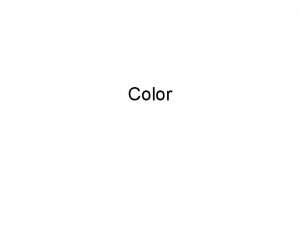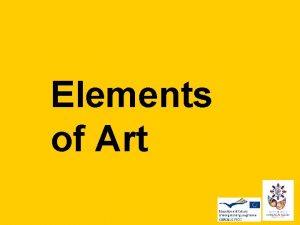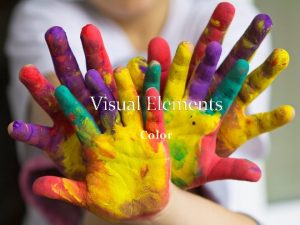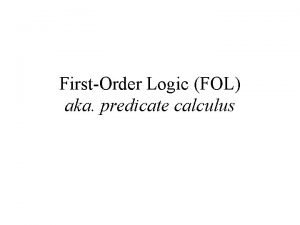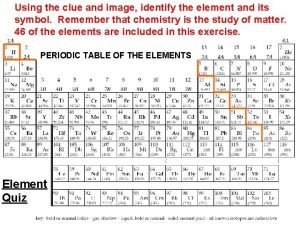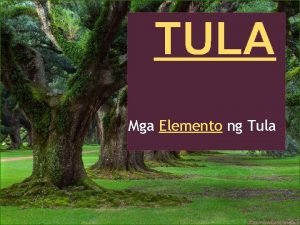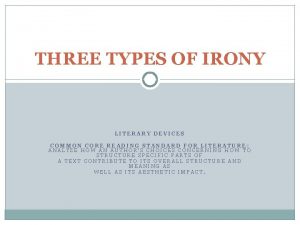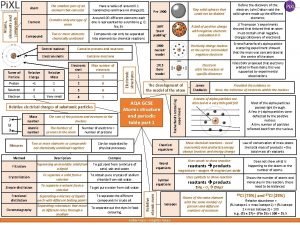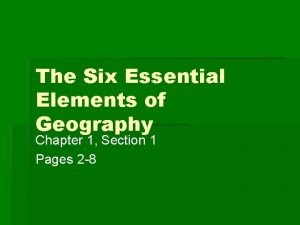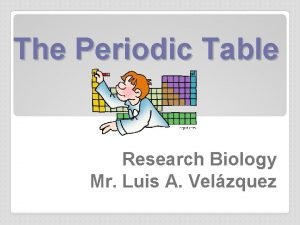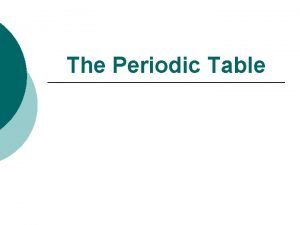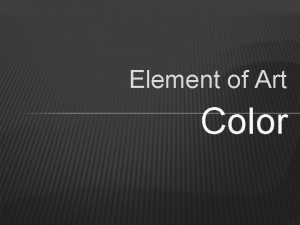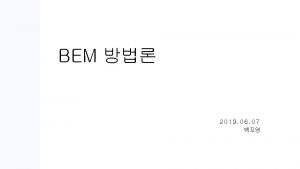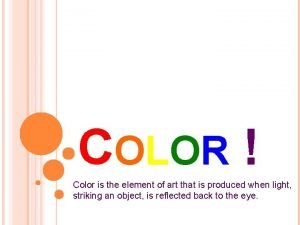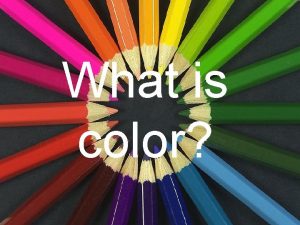What is color color is an element of




















- Slides: 20

What is color?

color is an element of design * it is important for us to first be able to understand color so that we can begin to master the element of design…

How is color perceived? * Color occurs when light in different wavelengths strikes our eyes. * Objects have no color of their own, only the ability to reflect a certain wavelength of light back to our eyes. * Colors appear different depending on whether you view them under incandescent, florescent or natural sunlight.

Natural light Incandescent light Fluorescent light

What is hue? * Hue refers to the color itself. * Each different hue is a different reflected wavelength of light. * White light broken in a prism has seven hues: red, orange, yellow, green, blue, indigo and violet. * White light occurs when all the wavelengths are reflected back to your eye. * Black light occurs when no light is reflected to your eye.

Primary colors * The three basic colors that are used to create all of the other colors are known as the primary colors. º You cannot achieve these colors by mixing any other colors together. * These colors include: º Red º Blue º Yellow

Secondary colors * The three colors that are achieved from equal parts of two primary colors make up what we call the secondary colors. * These colors include: º Violet º Green º Orange

Tertiary colors * When you mix equal parts of one primary and one secondary color you achieve the tertiary colors. * These colors include: º º º Red-violet Blue-green Yellow-orange Red-orange

* All of these elements; primary, secondary, and tertiary make up what we call the color wheel. T S T P T The Color wheel P S T P T S T * The colors used in the color wheel are called saturated colors because there is no white or black in them.

Tints & Shades * A tint is a saturated color that is mixed with pure white color. º The more white that you add to a saturated color, the lighter the color will become. * A shade is a saturated color that is mixed with pure black color. º The more black that you add to a saturated color the darker the color will become.

Warm & Cool Colors Warm Colors: Red, Orange, & Yellow Cool Colors: Blue, Green, & Violet

Neutral Colors * Black, Grey, White, Brown, & Tan

Color Harmonies * * * Monochromatic Analogous Complementary Triadic Split Complementary Neutral

Monochromatic Color Harmony * They are achieved by using tints and shades of only one color * Examples: * Navy Blue, Bright Blue, and Baby Blue * Cranberry, Brick Red, Red * Dark Green, Kelly Green, Light Green

Analogous Color Harmony * Are done by using three or more colors that are next to each other on the color wheel * Examples: * Red, Red-Violet, Violet * Blue, Blue-Green, Green * Yellow, Yellow-Orange, Red. Orange

Complementary Color Harmony * Two colors that are directly across from each other on the color wheel * Examples: * * * Yellow & Violet Green & Red Blue & Orange

Triadic Color Harmony * Three colors that are located within equal distance of each other * Examples: * Red, Blue, Yellow * Orange, Violet, Green

Split Complementary Harmony * This is created by using any color and the two colors located next to that colors complement * Examples: * Yellow, Red-Violet, Blue-Violet * Orange, Blue-Green, Blue-Violet * Red, Yellow-Green, Blue-Green

Neutral Color Harmony • Any combination of Blacks, Greys, Whites, Browns, & Tans

Summarize What type of color scheme is pictured here?
 Difference between signal element and data element
Difference between signal element and data element Signal element vs data element
Signal element vs data element Color element
Color element What is the most expressive element of art?
What is the most expressive element of art? The spectrum bent into a circle
The spectrum bent into a circle Visual elements color
Visual elements color Forward chaining
Forward chaining What is a parenthetical element
What is a parenthetical element Wisconsin math council
Wisconsin math council Plot
Plot 12 neutrons; metal; 11 electrons
12 neutrons; metal; 11 electrons A transition metal used in incandescent light bulbs
A transition metal used in incandescent light bulbs Which subatomic particle has a positive charge
Which subatomic particle has a positive charge Ibigay ang 8 elemento ng tula
Ibigay ang 8 elemento ng tula Poetic devices irony
Poetic devices irony What is the smallest part of an element
What is the smallest part of an element 6 essential elements of geography
6 essential elements of geography 1st man made element
1st man made element Glenn seaborg contribution to the periodic table
Glenn seaborg contribution to the periodic table How to find out group and period of an element
How to find out group and period of an element The element of plot
The element of plot



